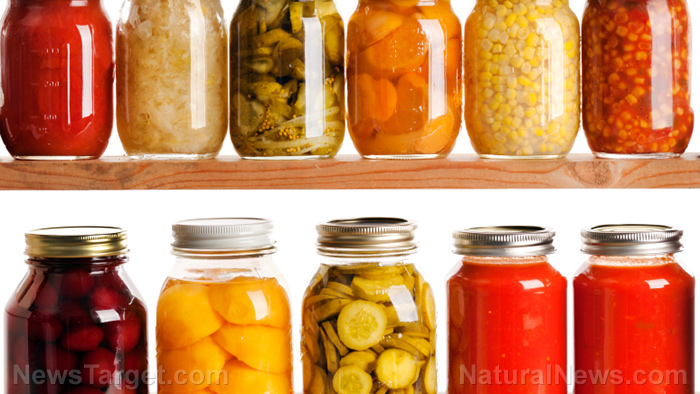
How to quickly pickle a variety of veggies
Monday, May 21, 2018 by Zoey Sky
http://www.preparedness.news/2018-05-21-how-to-quickly-pickle-a-variety-of-veggies.html

Pickling is a good way to extend the shelf life of fresh produce, especially if you want to stock up on winter vegetables during summer or vice versa. Almost any vegetable can be pickled, as long as it’s fresh. (h/t to Blog.PaleoHacks.com.)
Pickling basics
Once you’ve decided on what you’re going to pickle, select produce that doesn’t have bruises or wrinkles. Rinse the produce and use a vegetable brush to remove any remaining dirt.
If you don’t know where to start, here are some seasonal vegetables that you can pickle:
- Winter – Beets, cabbage, carrots, cauliflower, onions, or winter squash
- Spring – Asparagus, beets, cabbage, or celery
- Summer – Cucumber, peppers, or summer squash
- Fall – Brussels sprouts, cabbage, cauliflower, turnips, or winter squash
Now that you have your vegetables, decide on how you’re going to flavor them. Here are some herbs and seasonings that you can use:
- Clove – For a warm spiced flavor and aroma
- Coriander seed – For a nutty and citrusy flavor
- Fresh dill – For a strong grassy note
- Peppercorns – For mild spiciness
- Mustard seed/ground mustard – For a sharp tang
You can go with either fresh or dried herbs like dill, oregano, rosemary, or thyme. However, avoid fresh basil because it will turn mushy in the brine. (Related: Stockpiling perishables: How to store fresh fruits and vegetables for the long term.)
Brine is a crucial component of pickling. Brine is the saltwater solution that pickles the vegetables, and it imbues the final product with some important gut-boosting benefits.
While white vinegar is traditionally added to the brine, the recipes below use apple cider vinegar (ACV) because it has strong antiviral properties. ACV is full of enzymes, probiotics, and proteins that can help keep your gut flora in check. The recipes also use raw honey instead of sugar since the former is soothing and full of beneficial amino acids.
You will need a 16 ounce (oz) Mason jar and a saucepan for several of the recipes below. Before you start pickling, make sure all jars and lids are properly washed in hot soapy water. Rinse and dry everything completely.
Take note that the total cook time for most of the vegetables listed below is 24 hours and five minutes. Prep time will take 10 minutes.
Prepare the ingredients for the pickled vegetable of your choice:
For dill pickles:
- 1 ½ cups sliced cucumbers
- ¼ teaspoon (tsp) sea salt
- ½ tsp peppercorns
- 4-6 fresh dill sprigs
- ¼ tsp ground mustard seed
- ½ cup distilled water
- ½ cup apple cider vinegar
- 2 tablespoons (tbsp) raw honey
For pickled dill carrots:
- 1 medium carrot (sliced into ½-inch sticks)
- ½ tsp sea salt
- ½ tsp peppercorns
- 2 sprigs fresh dill
- ½ cup distilled water
- ½ cup apple cider vinegar
For pickled dill radishes:
- 1 ½ cup radishes (sliced, you can use rainbow radish)
- ½ tsp sea salt
- ½ tsp peppercorns
- 1 sprig fresh dill
- ½ cup distilled water
- ½ cup apple cider vinegar
Instructions:
- Place the washed and sliced vegetables in a Mason jar with the herbs and spices.
- Heat the water over low heat in a saucepan until it starts to boil, then turn off the heat.
- Stir in the apple cider vinegar and honey (if applicable in the recipe that you’re following).
- Pour the brine over the vegetables and secure the lid. Allow to cool at room temperature.
- Refrigerate 24 hours before serving. These pickled vegetables can stay fresh in your fridge for at least one month.
The cooking time for this pickled ginger recipe is 24 hours and 30 minutes and it serves eight oz. You will need an eight oz Mason jar, a saucepan, and a strainer.
For quick pickled ginger:
- 8 oz ginger (peeled and very thinly sliced)
- ¼ tsp sea salt
- 2 ¼ cups distilled water (divided)
- 3 tbsp raw honey
- ¼ cup apple cider vinegar
Instructions:
- Put the sliced ginger in a saucepan and cover it with salt and two cups of water. Bring to a boil.
- Reduce the heat to low and simmer for 15 to 20 minutes. Let the ginger soften, then strain.
- Add the ginger slices to the Mason jar. Heat the remaining ¼ cup of water in the saucepan over medium heat until it steams.
- Turn off the heat and stir in the honey and apple cider vinegar. Pour the brine over the ginger and close the lid.
- Cool at room temperature. Refrigerate the pickled ginger at least 24 hours before serving.
Additional pickling tips
Keep this additional tips in mind so you can have a hassle-free time when pickling the vegetables of your choice:
- Always pick fresh vegetables. Don’t pickle waxed supermarket produce.
- Clean the produce well to prevent dirt from contaminating the final product.
- Measure and weigh your ingredients carefully since the proportion of fresh food to other ingredients will affect the flavor of the finished product.
- Don’t over-pack your jars. Once the jar is processed it may be difficult to remove its contents or the brine may not circulate properly, leaving you with an imperfect product.
You can learn more about pickling and other food preparation methods at Foodsupply.news.
Sources include:
Tagged Under: Tags: brine, bug out, Collapse, disaster, food preparation, food supply, Homestead, homesteading, off grid, pickled vegetables, pickles, pickling, preparedness, preparedness and survival, prepper, prepping, preservation, SHTF, survival, survival food, survival skills, vegetables, Vinegar





